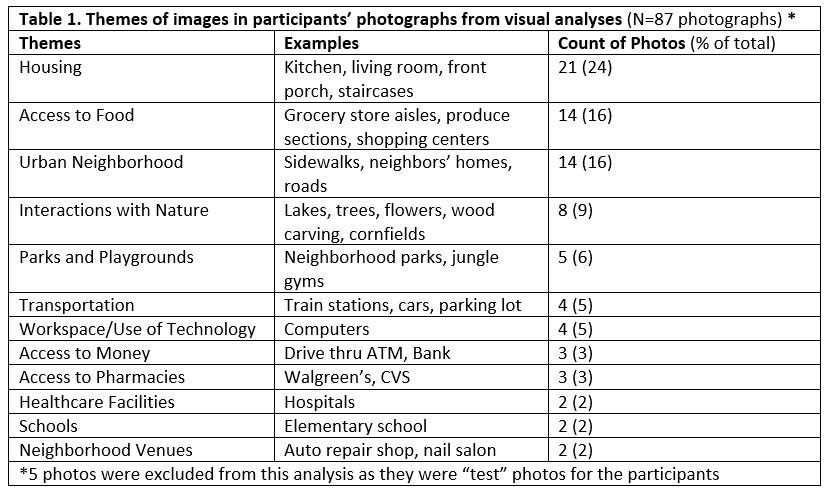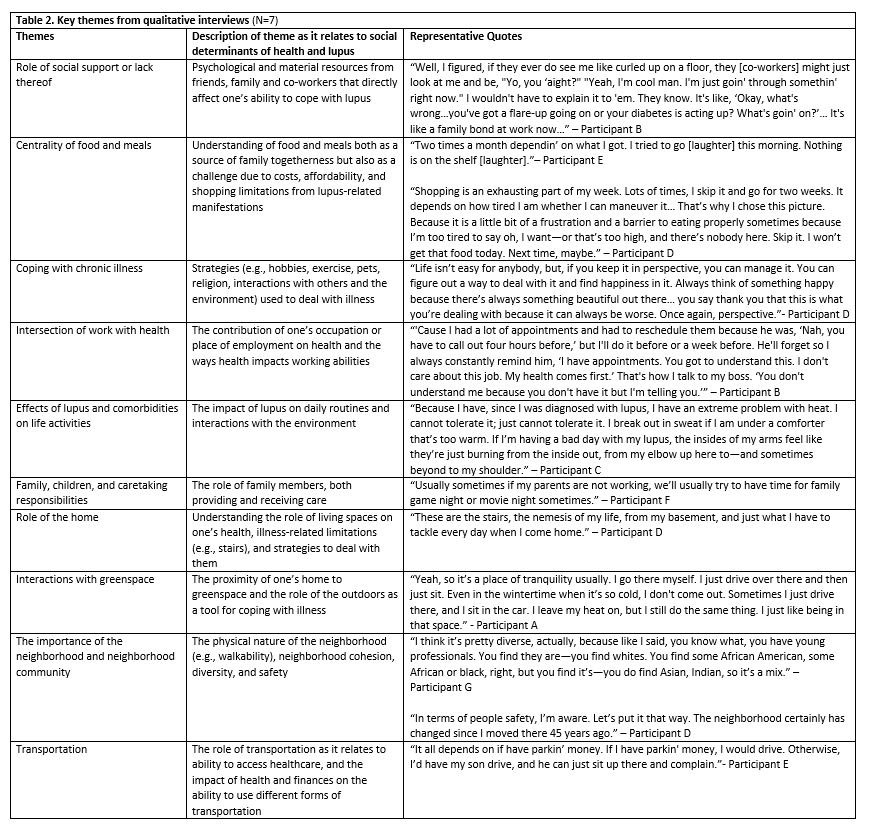Session Information
Session Type: Abstract Session
Session Time: 10:30AM-11:30AM
Background/Purpose: Photovoice is a participatory visual research method that provides individuals with cameras and empowers them to share aspects of their daily lives and environments as a tool for social change (Budig et al. 2018). Prior electronic medical record and survey-based studies have demonstrated the centrality of social determinants of health (SDoH) for individuals with systemic lupus erythematosus (lupus), but patient-centered studies are lacking. We invited individuals with lupus to photograph their homes, communities, and workplaces and to use these photographs to narrate an in-depth conversation about SDoH.
Methods: We recruited adults (≥18 years) diagnosed with lupus receiving rheumatology care at an academic medical center. Due to their medical and/or psychosocial complexity, participants were either enrolled in or eligible for a primary care-based care coordination program. Participants were given a disposable camera or used their smartphone to take 10-15 photographs of aspects of their environment that influenced their health. Once the photographs were received, participants engaged in a 45-60-minute semi-structured, in-depth photo-elicitation interview with a trained moderator using a structured guide developed a priori. Interviews were audio-recorded, transcribed verbatim, and entered in Dedoose™. Qualitative analyses used a modified grounded theory approach. Visual analysis strategies were used to understand patterns and themes across photographs. Transcript and photograph analyses were conducted independently by two team members (SU, CHF); discrepancies were adjudicated.
Results: Seven participants with lupus submitted 87 photographs (mean 12.4/participant) and engaged in a photo-elicitation interview. Participants’ mean (SD) age was 47 (20), 71% were female, 57% identified as Black or African American and 86% as non-Hispanic. 57% used a disposable camera, 43% used their smartphone. Twenty-one photographs taken by 5 individuals included representations of participants’ homes (e.g., rooms, front porch), 14 photographs taken by 5 individuals included images of grocery stores, and 14 photographs taken by 4 participants included aspects of their urban neighborhoods (Table 1). Qualitative analyses of the interviews revealed themes such as the centrality of food and family meals, the importance of green space, the role of social support, and the intersection of work and health (Table 2). Participant-led discussions focused on positive and negative aspects of their neighborhoods, homes, access to food, and the effects of lupus on their daily lives.
Conclusion: The photovoice method enabled patients with lupus to share unique elements of the interplay of their environment and health that are not routinely available to healthcare providers or researchers (e.g., food acquisition, social support, and the built environment). With the participants’ permission, we were able to convey critical findings to their providers, such as reasons behind missed appointments related to family needs or employment, and the need for supplemental food benefits. We are planning an exhibit to display these photographs to rheumatologists to advocate for awareness of the importance of understanding SDoH.
To cite this abstract in AMA style:
Ulysse S, Taber K, Williams J, Lorenz L, Feldman C. Empowering Patients with Lupus Through Their Photographs: Application of the Photovoice Method to Understand Social Determinants of Health [abstract]. Arthritis Rheumatol. 2022; 74 (suppl 9). https://acrabstracts.org/abstract/empowering-patients-with-lupus-through-their-photographs-application-of-the-photovoice-method-to-understand-social-determinants-of-health/. Accessed .« Back to ACR Convergence 2022
ACR Meeting Abstracts - https://acrabstracts.org/abstract/empowering-patients-with-lupus-through-their-photographs-application-of-the-photovoice-method-to-understand-social-determinants-of-health/


